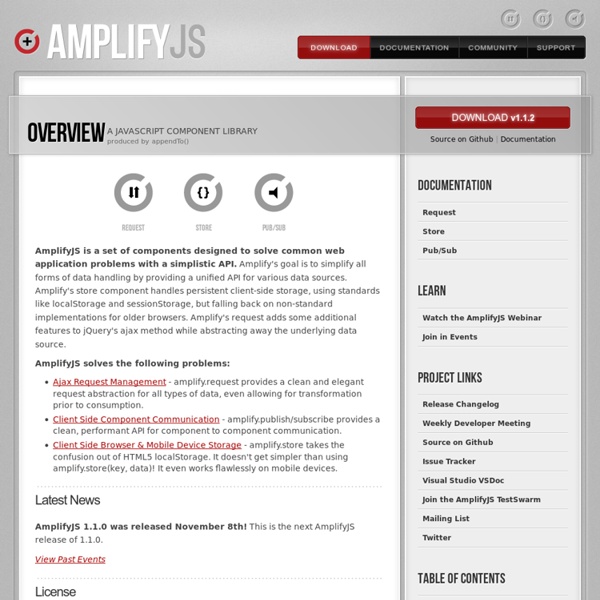



Packery jQuery++ jQuery Async Project page » Asynchronous button Instead of using the .click() jQuery function, use the .async() to make your button visibly wait. The action can either succeed of fail, triggering a different animation on the button. Test asynchronous user action Action succeeds Action failed Embed the params in the HTML attributes If your javascript is bundled and minified, you cannot easily pass a page parameter like a user id to the javascript function. jQuery async does that for you by reading the async-params attribute of your button in a JSON format and deliver it in your code Test embedded params Different triggers You can bind .async() on a different trigger than the usual "click" event In this example the async is binded to the "change" event so once you have typed in the postal code and you leave the input, the function is triggered:
Reducing bad signup emails with mailcheck.js | Andrew Berls I recently stumbled across mailcheck.js, a little jQuery plugin from Kicksend that suggests domains based on common typos in email forms. For example, 'user@gnail.co' will generate a suggestion for 'user@gmail.com'. It's perfect for preventing errors in user signups, and the authors claim its reduced their email bounces by 50%. After playing around with it, I've decided to bundle it into production for most, if not all of my projects, and this is just a brief demo of what can be done with it. Getting Set Up Our goal is to create a simple display that shows email suggestions to the user and offers a way to automatically fill in the field with the suggestion. The setup is only a few lines, although it's important to understand what's going on. Using the suggestion object Mailcheck automatically generates our field suggestions for us, but how do we use them? We have access to the address (what comes before the @), the suggested domain, and the entire suggested text.
Unheap – A tidy collection of jQuery plugins Fuel UX Example Below is a working radio example. Using radio Call the radio via javascript (optional): $('#myRadio').radio() If you need to deactivate a radio button, the only way to do this currently is through javascript using: //note that this will deselect ALL radio buttons on the page. Methods Fuel UX's radio exposes the following methods: Markup You can activate radio on your page easily without having to write a single line of javascript. <label class="radio radio-custom"><input type="radio"><i class="radio"></i>Item One</label> Additionally, you can add a highlight effect to the radio control by adding the class highlight to its label element.
AmplifyJS is a set of components designed to solve common web application problems with a simplistic API. Amplify's goal is to simplify all forms of data handling by providing a unified API for various data sources. Amplify's store component handles persistent client-side storage, using standards like localStorage and sessionStorage, but falling back on non-standard implementations for older browsers. Amplify's request adds some additional features to jQuery's ajax method while abstracting away the underlying data source. by web101 May 1